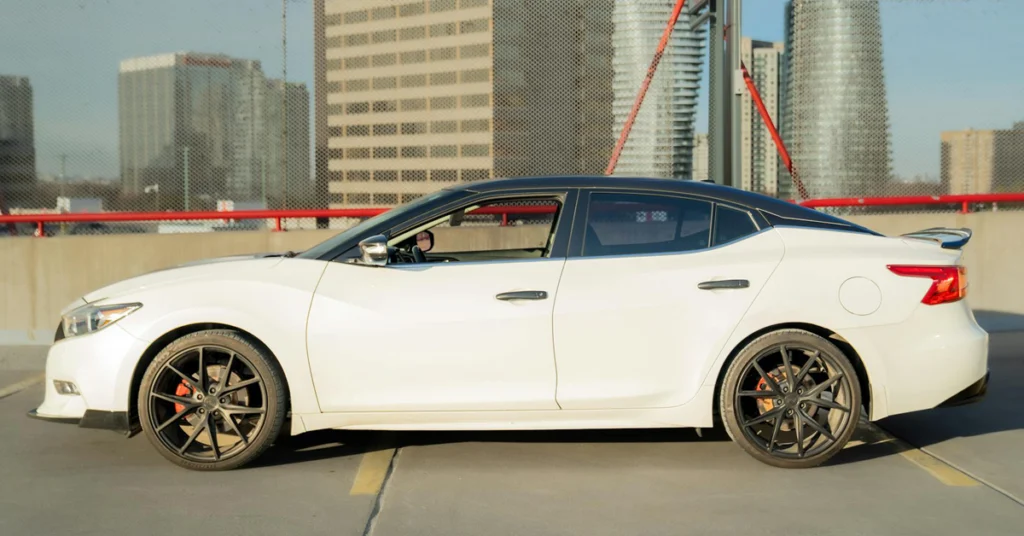If you’ve ever slipped behind the wheel of a Nissan Maxima, you’ll understand why it’s often called the “four-door sports car.” It’s quick, composed, and surprisingly refined for something wearing a Nissan badge. But talk to a few owners, and you’ll hear mixed stories some swear by its bulletproof V6, others grumble about its moody transmission. So what’s the truth? Can the Maxima still be trusted as a used-car buy, or are there years you should steer clear of? Let’s dig in.
Why the Maxima Deserves a Second Look
Few sedans manage to blend sporty attitude with everyday comfort the way the Maxima does. It’s the sharper, more sophisticated cousin to the Altima with more power, better handling, and a cabin that feels just a touch premium. According to RepairPal, it scores 4 out of 5 for reliability, ranking 9th among 32 brands in the same category. Many owners have driven theirs well beyond 200,000 km with nothing more than routine maintenance.
The catch? That strong performance comes with complex mechanicals a high-output V6 paired with a continuously variable transmission (CVT). Neglect service intervals, and the Maxima’s smooth ride can quickly turn rough.
Before we dive into the gritty details, here’s what this guide covers:
- The Maxima’s real-world reliability record
- The most common problems (and how to prevent them)
- The best and worst model years for used buyers
- Recommended maintenance schedule
- How it stacks up against rivals like the Toyota Avalon and Honda Accord
Reliability in the Real World
For most drivers, the Maxima’s 3.5-litre V6 is a highlight. It’s responsive, refined, and remarkably durable when serviced on time. Where owners start to complain is with the CVT gearbox. Earlier versions (especially before 2016) were known to overheat or jerk under load, particularly in hot climates where cooling was inadequate. The good news? Later models received better tuning and improved cooling systems.
Beyond the transmission, the car’s electrical reliability has improved steadily over the years. Post-2014 cars show fewer random fault codes and less electronic gremlins a sign Nissan learned from early mistakes.
Common Nissan Maxima Problems and Fixes
1. Air-Conditioning Hose Leaks
Many 2004–2012 models suffer from cracked or leaking AC hoses, leaving the system low on refrigerant and blowing warm air.
Fix: Inspect the lines every service cycle and replace any corroded or damp sections early. Catching leaks early prevents compressor damage.
2. Transmission Malfunctions
The CVT is the most controversial part of the Maxima. Some 2004–2006 and 2014 units develop jerky shifts or slow acceleration before eventually failing.
Fix: Use only genuine Nissan CVT fluid and change it every 60,000 km. If you live in a hot region, fitting an auxiliary transmission cooler helps the gearbox survive long-term
3. Electronic Steering Column Lock Failure
A known issue on 2009–2010 models, where the steering lock refuses to release, leaving the car immobilised.
Fix: Nissan ran a service campaign to replace the defective unit free of charge. Confirm with the dealer that your car’s recall work is recorded.
4. Faulty Front-Seat Wire Harness
In some 2006 cars, wiring under the driver’s seat was routed incorrectly and could short out, risking fire.
Fix: This was addressed under a factory recall. Check service records before buying any used 2006 model.
5. Brake-System Faults
Early production of the 2016 Maxima had brake calipers that weren’t properly secured and some cars left the factory with low brake fluid.
Fix: If you feel inconsistent braking, have the system inspected. Most cars were repaired under recall, but it’s worth verifying.
6. Ignition-Coil Failure
Older models (1995–2009) often misfire due to failing ignition coils.
Fix: Replace coils in full sets and keep spark plugs fresh every 60,000–80,000 km to maintain smooth performance.
7. Power-Steering Pump Leaks
Cars built between 1995 and 2001 can leak fluid from the steering pump, damaging nearby suspension bushings.
Fix: Regularly inspect for leaks and avoid over-turning the wheel at full lock, which strains the pump.
Recommended Preventive Maintenance
A well-maintained Maxima can comfortably cover 300,000 km without major drama. Stick to this maintenance rhythm and it’ll reward you with smooth, confident motoring.
| Service Item | Recommended Interval | Notes |
| Engine oil & filter | Every 10,000 km or 6 months | Use synthetic oil suitable for the VQ-series V6 |
| Transmission fluid (CVT) | Every 60,000 km | Use genuine Nissan CVT fluid only |
| Brake fluid | Every 2 years | Replace to maintain pedal feel |
| Coolant flush | Every 2 years | Keeps engine temperature stable |
| Air & cabin filters | Every 20,000 km | Replace sooner in dusty regions |
| Spark plugs | Every 80,000 km | Stick to OEM-spec parts |
| Steering & suspension check | Every 40,000 km | Detect leaks or bushing wear early |
| Battery & electrical system | Annually | Prevents start-up issues |
Best and Worst Nissan Maxima Model Years
If you’re eyeing a used Maxima, these are the years that make the most sense and those that might drain your patience.
| Best Years to Buy | Why They Stand Out |
| 2016–2017 | High reliability, strong safety ratings, minimal recalls |
| 2013–2014 | Balanced performance, refined CVT tuning |
| 2019 | 5-star safety rating, solid reliability, improved infotainment |
| 2009 | Simple design and fewer electronic issues |
| Years to Avoid | Typical Problems |
| 2002–2003 | Frequent recalls and low reliability scores |
| 2004–2006 | Transmission and wiring faults |
| 2010–2011 | Steering and electrical malfunctions |
| 2012 | Weak safety rating, inconsistent reliability |
| 2018 | Early production bugs following redesign |
How the Maxima Compares with Its Rivals
| Model | Powertrain | Reliability | Ride Comfort | Tech Features | Resale Value |
| Nissan Maxima | 3.5 L V6 CVT | ★★★★☆ | ★★★★☆ | ★★★☆☆ | ★★★☆☆ |
| Toyota Avalon | 3.5 L V6 Auto | ★★★★★ | ★★★★☆ | ★★★★☆ | ★★★★☆ |
| Honda Accord V6 (Old Gen) | 3.5 L V6 Auto | ★★★★☆ | ★★★★☆ | ★★★★☆ | ★★★★☆ |
| Chrysler 300 | 3.6 L V6 Auto | ★★★☆☆ | ★★★★☆ | ★★★☆☆ | ★★☆☆☆ |
| Infiniti Q50 | 3.0 L Turbo V6 | ★★★☆☆ | ★★★☆☆ | ★★★★☆ | ★★★☆☆ |
The Maxima sits squarely in the middle: sportier than an Avalon, more refined than a Chrysler 300, and generally cheaper to run than an Infiniti Q50.
Quick Problem-and-Solution Recap
- Transmission hesitation change CVT fluid on time, add cooling if needed
- AC not cooling check for hose leaks every 40,000 km
- Steering lock fault verify recall completion
- Brake feel issues inspect calipers and replace fluid regularly
Staying on top of these points keeps the car running strong and prevents small issues from snowballing into expensive repairs.
Final Thoughts
The Nissan Maxima doesn’t always get the credit it deserves. It’s fast, comfortable, and still looks great even years after launch. Yes, some older models had rough patches mainly transmission and electrical quirks but later years corrected most of those flaws. A well-maintained 2014–2019 Maxima is a genuinely enjoyable daily driver that mixes performance with long-haul comfort. Choose wisely, keep up with routine maintenance, and you’ll have a dependable sedan that easily covers hundreds of thousands of kilometres.
Service Your Nissan Maxima with MotorHub UAE
Keeping your Maxima running like new is easy when you have the right people looking after it. At MotorHub, you can find trusted Nissan specialists across the UAE who handle everything from CVT servicing and A/C diagnostics to detailed preventive maintenance.
MotorHub Your trusted car-service partner in the UAE.



